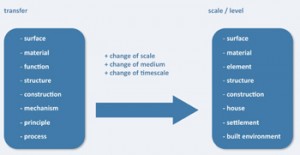(input lecture by Petra Gruber June 2010)
Biomimetics in architecture is the use of biomimetics as innovation tool for application in architecture. It is an emerging field that develops the interest of architects and designers in role models from nature further to a new discipline. The strategic approach differentiates biomimetics from mere inspiration from nature, that has always existed in architecture, arts and technology. Bioinspiration can transfer pure morphological aspects, whereas in biomimetics functional aspects play a key role. In general, materials, structures and processes from nature can find biomimetic transfer to new technical solutions (an overview of Biomimetics in architecture is to be found in P. Gruber: “Biomimetics in architecture – the architecture of life and buildings” 2001). Until recently the methodology of biomimetics in architecture was only roughly described, meanwhile there are a few attempts to grasp the process and discern distinct phases and methods (works of Thomas Speck, University of Freiburg, and Biologically Inspired Design group, Georgia Techn University).
In the Biornametics project, the introduction of a biomimetic approach was meant to deliver a strong connection between the role model from nature and the architectonic interpretation, going beyond inspiration and transfer of form. Several possibilities for application of patterns are foreseen. The basic ornamental depiction of natural patterns from nature would be the most simple translation. In the case of the Ricola Mulhouse factory (Herzog & de Meuron 1993) the facade panels are printed with a repetitif plant motif derived from a famous photograph, delivering also a symbolic information on the functional use of the building. Facades lend themselves for application fields of 2D as well as 3D elements having aspects from nature as an underlying model. One of the first active adaptive facades was carried out in the Institut du Monde Arabe in Paris (Jean Nouvel 1988), using a system of technical apertures to control light conditions inside. Recent projects, the EmTech diploma program at the Architectural Association being on the forefront of these, use computer aided technologies to transfer differentiated elements from nature to building shells.
 Figure: Scheme of transfer from Biology (left) to Architecture (right), aspects to be transferred and scales or levels for application in an architectural context[1]
Figure: Scheme of transfer from Biology (left) to Architecture (right), aspects to be transferred and scales or levels for application in an architectural context[1]
[1] P. Gruber: Biomimetics in architecture, in: P. Gruber et al. (Eds.): Biomimetics, Materials, Structures, Processes, Springer 2011